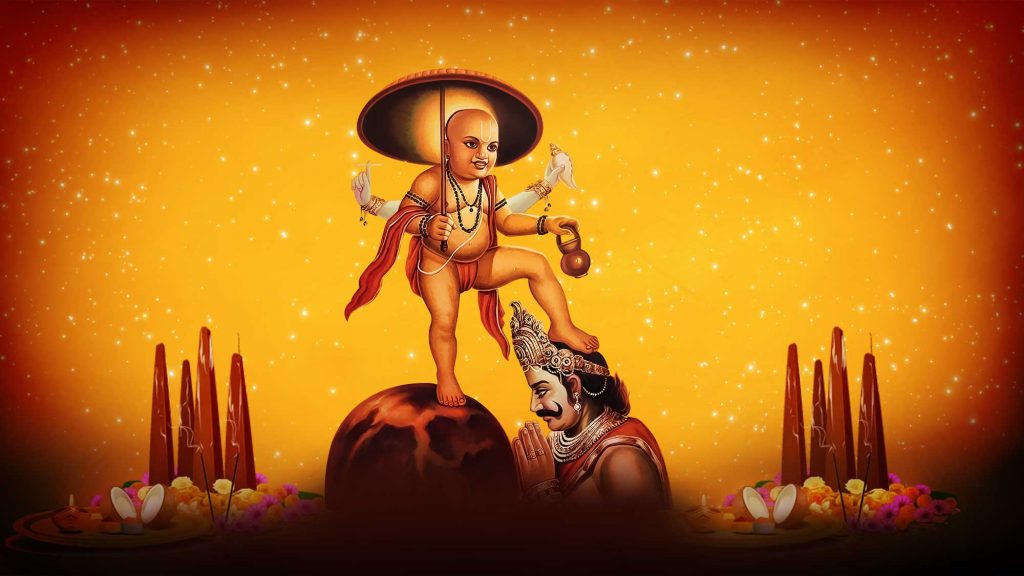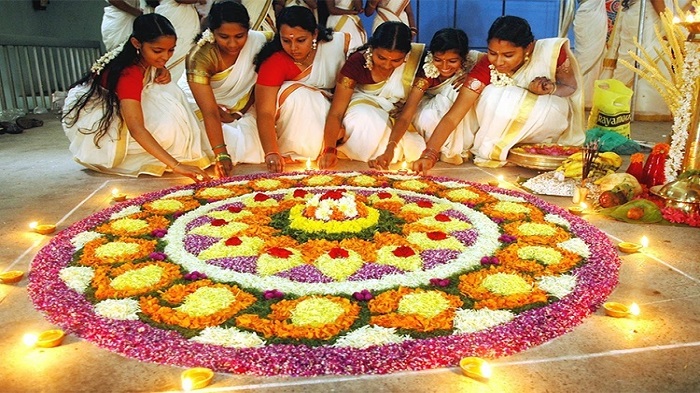If It’s Food, Flamboyance And Festivities, It’s Onam

No festival is as colourful and vibrant as Onam, the annual 10-day harvest festival of Kerala. The air is filled with a palpable, infectious joy as people take to the streets and engage in traditional festivities like the Pulikali dance and Pookallam, among others. Celebrated at the end of monsoon, Onam holds both religious and cultural significance for the people of Kerala, promoting communal harmony while also reinforcing numerous Hindu rituals.
History of Onam

The history of Onam can be traced back to the ancient tale of Mahabali, the Asura (demon) king who was ruler of the three worlds, conquering the Underworld and Heaven as well as Earth. He had a reputation for being a benevolent, judicious and generous leader who brought prosperity to his loyal subjects. Not all were happy, however. Envious of the adulation he received, the gods wished to eliminate the threat he posed to their superiority. So, their patron, Lord Vishnu took the form of a dwarf Brahmin boy named Vamana and approached Mahabali, asking him simply for “three paces of land”. Out of his kindness, Mahabali agreed, but little did Mahabali know that Vamana would soon expand to take up all of Mahabali’s kingdom in just two paces! For the final pace, with no place else remaining, Mahabali offered his own head, and Vamana/Vishnu accepted his offering, banishing him to nether realms. However, for his absolute devotion and sacrifice, Mahabali was granted one wish by the Lord: to visit his former kingdom and subjects once a year. This yearly return has come to be known as Onam.
Suggested Read : Experience The Magic of Temple Festivals in Kerala
Onam Celebrations

The grandiose and majestic processions of the festival know no bounds and transform Kerala into a dynamic living organism. Onam is typically a ten-day celebration. It kicks off with:
Tripunithura Athachamayam, an event that takes place exclusively in the city of Tripunithura, 10 km from Kochi. Mahabali’s grand return is heralded by an animated and flamboyant street parade that features marching elephants that are adorned with jewellery, costumes and regalia. Tableaus depicting famous mythological and historical scenes are also seen. The streets are filled with the sound of beating drums as musicians, folk artists and commoners dressed in lively traditional attire partake in this journey from Tripunithura to the Vannamoorthy Temple in Thrikkakara. Originally a royal ceremony that the king performed dating back to when Kerala was ruled by Maharajas, the parade survives today as an integral part of the festival.
Within this parade (and other events on subsequent days), you are sure to see the Pulikali Dance, an art form introduced more than 200 years ago by the ruling Maharaja. It began as a way to display manliness and a sense of “macho” exuberance that came with Onam and remains a popular form of entertainment. Pulikali, which literally translates to “tiger play”, sees performers donning full body paint and masks to completely take on the appearance of a tiger. The theme of the dance typically revolves around tiger hunting.
Pulikalli can best be seen in Thrissur on the fourth day. Alternatively, you may catch a glimpse of Theyyam, a more religious dance that offers worship to the Lord.
On this first day, the construction of the intricate floral arrangements known as Pookallam also begins. These beautiful flower carpets with their layered and complex designs can be seen on the doorstep of most houses and temples. Indeed, there are a number of Pookallam competitions across Kerala during this time. It is customary to place an Onathappan statue (a pyramid shaped figure that symbolises Vamana) in the centre of Pookallam decorations.
Vallamkali or the Snake boat races usually begin on the fifth day and are easily the most iconic and recognizable events of Onam. Citizens and tourists alike flock to see these high-adrenaline competitions which have teams of rowers paddle in long, hooked, snake-shaped canoes and battle against each other for a grand prize. Various events take place across the backwaters of Kerala, but notable ones include the Nehru Trophy and President’s Trophy boat races that take place in Alappuzha and Kollam respectively. Recently, however, due to excess flooding, the government has sometimes been forced to delay these races to prevent any undue loss of life.
Any celebration of Onam would be incomplete without food – Onam is a harvest festival, after all – and Hindu temples and households begin serving a traditional meal called the Onam Sadhya around the seventh day. An indispensable part of Onam festivities, a Sadhya is a 13 (or more) course vegetarian meal served on a banana leaf that samples a wide variety of dishes and condiments from Kerala’s delicious cuisine. Anywhere from 10 to 30 dishes may be served in total, which include staples such as avial, molosyam, rasam, mezhukupuratti, sambhar, and parippu, all of which are served with parboiled brown rice and fried pappadam. At the end of the meal, a scrumptious dessert course featuring different kinds of payasaam (kheer) washes away the more savoury flavours. Onam Sadhya is a mainstay of Thiruvonam, the tenth and final day, and creates a feel of community as Muslims, Christians and Hindus sit together side by side enjoying the nourishing meal. It is also an important time for family and friends to convene.
After Thiruvonam, the core festivities are over. But that hardly means the celebration ends there: the two days following Thiruvonam are designated “Third and Fourth Onam”, during which time Keralites prepare for Mahabali’s departure. The Onathappan statues in the Pookallam are removed and immersed in the sea, while the Pookallam itself is carefully cleaned away.
Aside from the more overzealous revelry, Malayalis also partake in simpler, smaller scale traditions. For example, they buy and wear new clothes specifically for the festival in a tradition called Onnakodi. Lamps and torches can be seen lit everywhere (especially in Hindu temples) to signify Mahabali’s sacrifice. Handloom fairs also see high attendance during this time.
Truly among the most exciting celebrations of our country, Onam is a time of great happiness and welfare for Malayalis. It is a treat for tourists to experience and should be a must-do on any bucket list.

Very much interesting but your co didn’t show such things while performing my tour during Oct 2016.